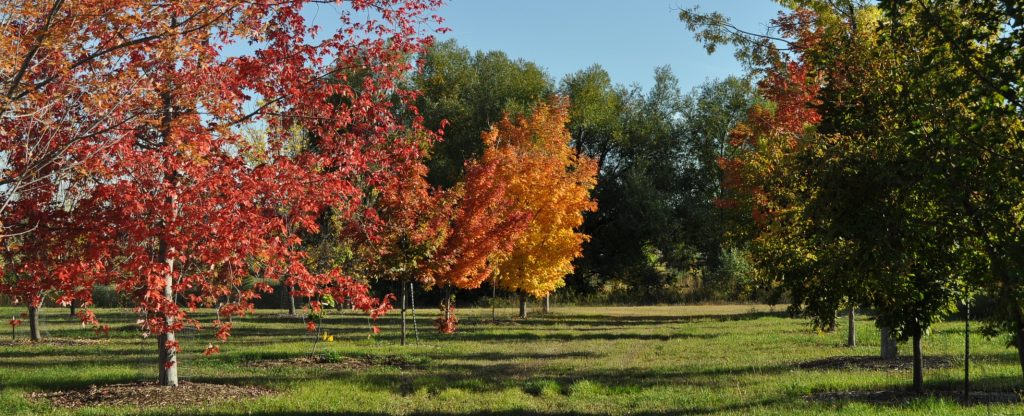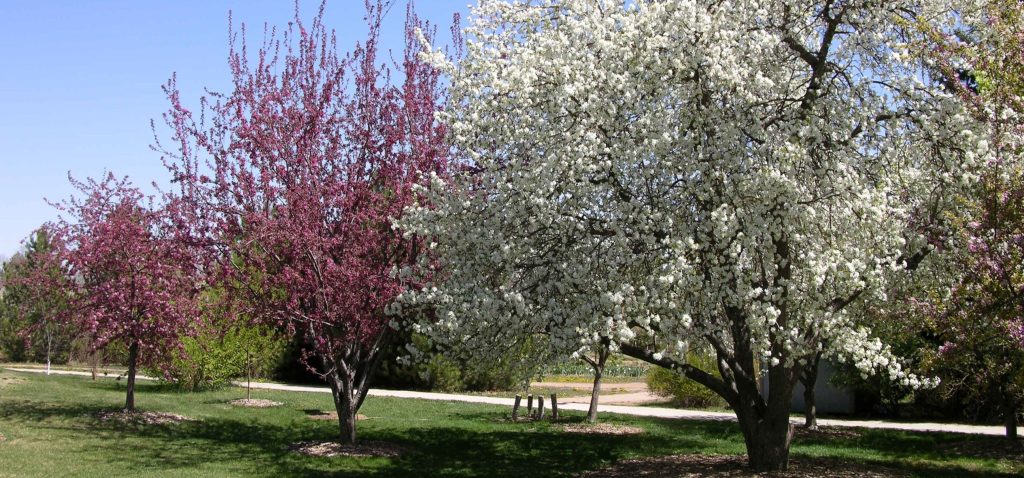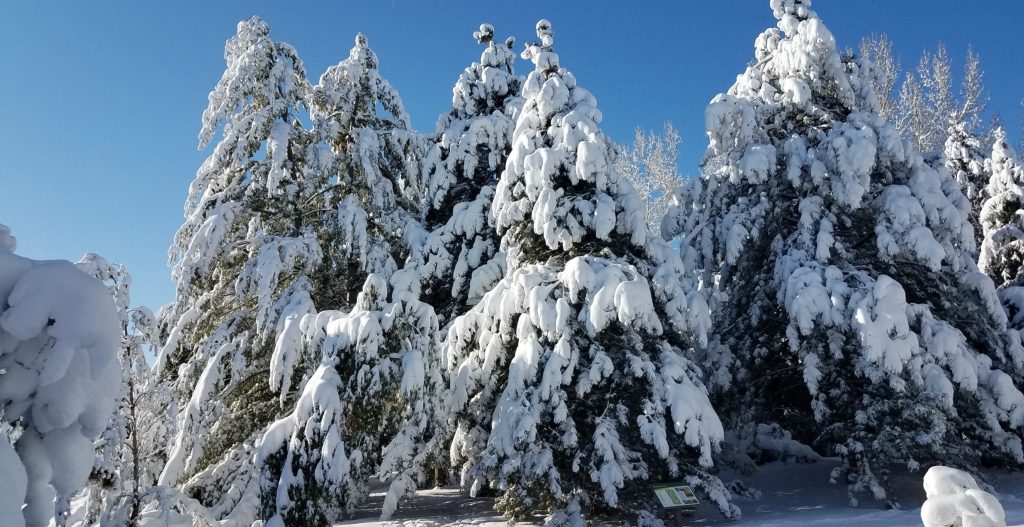What is an arboretum?
An arboretum is a place where trees, shrubs, and herbaceous plants are cultivated for scientific and educational purposes. more
The Colorado State University Heritage Arboretum was established to determine which woody plants are best suited for growing in the Rocky Mountain Area and display these plants for public and teaching purposes along with research. This collection consists of approximately 1,150 different taxa. Almost yearly, plants are evaluated by Colorado State University Horticulture staff based on growth, survival, habit, ornamental features and tolerance to environmental conditions. The results from this research are available to people throughout the state and region and can help them select the best woody plants for Colorado and beyond. These evaluations over the past 40 years have documented the dependable woody plants for this area. It is an important resource to help promote what is available to create a broader palette of plants to help combat the problems of monoculture plantings that are vulnerable to problems like the scourge of Emerald Ash Borer.
Heritage Arboretum General Information
The Colorado State University Heritage Arboretum is located at 800 West Lake Street, in the southwest corner of CSU’s Main Campus in Fort Collins, Colorado. more
Plant materials for the gardens are donated by nurseries and botanic gardens all over the country.
The Heritage arboretum began in 1975 as part of the Plant Environmental Research Center, when the University donated six acres of land to the Department of Horticulture and Landscape Architecture. Planting began in 1976. The arboretum was later expanded to a total of seven and one-half acres in 1991. In the spring of 2003, a new dormitory was constructed on campus, taking away one and one-half acres of the arboretum. Approximately 120 taxa that were located in this area were tree-spaded and moved to a new six-acre arboretum site on Center Avenue in Fort Collins, adjacent to the Gardens at Spring Creek. The Heritage arboretum is the main site for woody plant research trials in the region and contains more than 1,100 different plant taxa.
The outdoor grounds at Heritage arboretum and the Center Avenue site are free and open to the public every day during daylight hours. Display labels with scientific and common names are attached to the north side of each plant.
Download a walking map of Heritage Arboretum Here.

Growing Conditions
The arboretum is located in Fort Collins, Colo., at an elevation of 5,021 feet above sea level. more
Fort Collins is situated along the base of the Front Range of the Rocky Mountains, in an area called the High Plains region. It is considered a semi-arid environment and is characterized by low humidity, intense sunlight, and frequent winds. It is located in USDA Plant Hardiness Zone 5b, which is characterized by average minimum temperatures of -15 to -10°F. Average annual precipitation is approximately 14-16 inches. The arboretum is in a location that is fairly protected from winds, with buildings on two sides. The Center Avenue site is more open to winds and is in a flood plain area.
Soil testing in the arboretum at PERC indicates a sandy clay loam with an average pH level of 7.2 and organic matter content of approximately 4.5%. Soil tests of the Center Avenue arboretum indicate a sandy clay loam with an average pH of 7.1 and organic matter content of 3.4%.


Cultural Practices
Since many of the woody plants in the arboretum require more moisture than the average annual rainfall for the area, supplemental water is supplied through overhead irrigation as needed during the growing season. more
Approximately 5-8 additional inches of water are applied each year. Winter watering is also provided during extended dry periods. According to the design of the arboretum, plants are grouped by family, and plantings of two or three of the same plant are made whenever possible. The trees at the Center Avenue site are planted in rows and grouped by genus. Many of the woody plants are received as bare-root nursery stock, which are then containerized and grown in a lath house at PERC for 1-3 years or longer to gain some size before transplanting to the arboretum. A small amount of plants are received as containerized stock and even fewer as balled and burlapped plants.
Wood mulch is applied at the base of all woody plants at the time of planting to suppress weed growth and conserve moisture. Pro-Rich fertilizer (14-5-5) is added to the arboretum annually at a rate of 1 pound N per 1,000 square feet. The herbicide glyphosate (Roundup®?) is used in the arboretum to eliminate weeds and other unwanted plants, especially in mulched areas around the tree plantings.
In order to determine the resistance and susceptibility of the plants, no pesticides are used to control insects or disease. The arboretum plants are allowed to grow into their natural habits with no pruning for shape. Pruning of dead wood is done after evaluation data is taken, and broken branches due to storm damage or vandalism are removed as needed. Plants are sometimes pruned or removed in order to make space in the arboretum for new plants or the spreading growth of existing plants
Campus Wide Arboretum
Campus Arboretum
In 2015, the arboretum at the Plant Environmental Research Center was included as part of the greater Campus Arboretum project. moreIt was renamed as the “Heritage Arboretum” and the area south of the Horticulture Center was recognized as the “Centre Avenue Arboretum” The Campus Arboretum is overseen by the Campus Arboretum Committee, which includes representatives from Facilities Management, the Department of Horticulture & Landscape Architecture, CSU Extension, Plant Select, and the City of Fort Collins Dept of Forestry. The Colorado State Forest Service joins in during Tree Campus USA Higher Education activities. The website for the Campus Arboretum project is Colorado State University Campus Arboretum | Facilities Management | Colorado State University (colostate.edu).
ArbNet Level III Arboretum
The Colorado State University (CSU) Campus Arboretum and Botanical Garden embodies CSU’s land-grant heritage and mission by offering an engaging learning laboratory environment for students, employees, and community visitors. We manage trees diverse in terms of age (from newly planted to 140 years old), class, and species (approx. 300 species), distributed over three campuses (Main, South, and Foothills), comprising 2,400 acres of land. The largest trees have up to a 69” diameter at breast height (DBH), with an average trunk diameter of 10.65 inches. The most common CSU main campus tree is honeylocust (9.78 percent), followed by green ash (8.83 percent), blue spruce (7.15 percent), Rocky Mountain Juniper (5.72 percent) and Austrian pine (5.22 percent). We are actively and intentionally working to establish better species diversity, so our overall campus forest will be more resilient to invasive pests, climate change, and severe weather events.
The majority of CSU’s managed urban forest is located on the Main Campus within 220 acres of irrigated landscape. The Campus Arboretum leverages the investments of our historical and diverse urban forest, the Heritage Arboretum and Garden, CSU Horticulture Research Center, Annual Flower Trial Gardens, and the Perennial Garden at the University Center for the Arts. The CSU Campus Arboretum is an exceptional asset for the community, advancing individual programs and efforts around research and teaching through the overarching structure and prominence of the arboretum, while solidifying a legacy that preserves our urban forest for future generations.
ArbNet’s Arboretum Accreditation Program advances the planting, study, and conservation of trees, recognizing arboreta at various levels of development, capacity, and professionalism and fosters professionalism of arboreta worldwide. No other international program of accreditation exists specific to arboreta. Accreditation is based on self-assessment and documentation of an arboretum’s level of achievement of accreditation standards, including planning, governance, number of species, staff or volunteer support, education and public programming, and tree science research and conservation. Learn more about CSU’s ArbNet Accreditation Level III status and the Morton Register.
Campus Tree Tour
View 15 Notable Trees on the Tour (summer & winter images of the trees) CSU’s Notable Tree Tour on Main Campus is a self-guided tour of 15 signature trees including three notable campus tree collections at the Oval, Sherwood Forest, and the Heritage Arboretum. In 2021 the Campus Arboretum Committee received funding from the President’s Sustainability Commission sustainability fund to place 15 interpretive signs by the trees on the tour. Check out the tour by visiting the CSU interactive map and choosing the Tours tab or click on the map image (below), which will link to the interactive map. Want a paper map? Download here.
City of Fort Collins has a notable tree tour too – check it out here!
